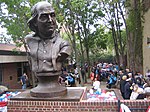Arch Street Friends Meeting House

The Arch Street Friends Meeting House, at 320 Arch Street at the corner of 4th Street in the Old City neighborhood of Philadelphia, Pennsylvania, is a Meeting House of the Religious Society of Friends (Quakers). Built to reflect Friends’ testimonies of simplicity and equality, this building is little changed after more than two centuries of continuous use. Pennsylvania founder and Quaker William Penn deeded land to the Society of Friends in 1701 to be used as a burial ground. The east wing and center of the meetinghouse was built between 1803 and 1805 according to a design by the Quaker carpenter Owen Biddle Jr. Biddle is best known as the author of a builder's handbook, The Young Carpenter's Assistant, published in 1805. The building was enlarged in 1810–11, with the addition of the west wing. Architects Walter Ferris Price and Morris & Erskine also contributed to the design and construction of the building. The firm Cope & Lippincott renovated the interior of the east wing and designed the two-story addition behind the center building in 1968–69.Today, the Meeting House continues to be a center for worship and the activities of the Monthly Meeting of Friends of Philadelphia and Philadelphia Yearly Meeting. Notable members of the Religious Society of Friends who worshiped at this meetinghouse include abolitionists and woman rights advocates Sarah and Angelina Grimke. Edward Hicks, the noted painter and cousin of Elias Hicks, also attended meeting here.The meetinghouse was listed on the National Register of Historic Places in 1971 and declared a National Historic Landmark in 2011. The latter designation was as a consequence of the building being the only surviving documented work by Owen Biddle.
Excerpt from the Wikipedia article Arch Street Friends Meeting House (License: CC BY-SA 3.0, Authors, Images).Arch Street Friends Meeting House
Arch Street, Philadelphia Center City
Geographical coordinates (GPS) Address Nearby Places Show on map
Geographical coordinates (GPS)
| Latitude | Longitude |
|---|---|
| N 39.952 ° | E -75.147269444444 ° |
Address
Wyndham Philadelphia Historic District
Arch Street 400
19106 Philadelphia, Center City
Pennsylvania, United States
Open on Google Maps







